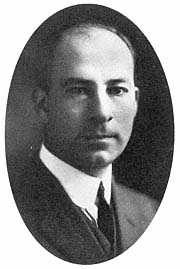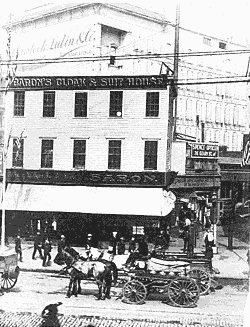Forging Frameworks for Housing Change
Early housing reform organizations in California had elements similar to their models and counterparts on the East Coast. Dedicated volunteer activists privately defined a problem, became the leading experts as they gathered the best (or only) information, galvanized the support of people with influence, and having talent and good timing, shifted quickly from doing small local projects to influencing major legislation. When a friendly administration established an official agency, the lead

Figure 8.2
Portrait of Simon Lubin in 1913.
Lubin had just begun his work
as president of the Commission
of Immigration and Housing.
private reformer became the public agency head.[1] Thus, in California as elsewhere, the circuits of information and the conduits of antihotel opinion were directed by a relatively small number of people.
In California, the housing reform process was exemplified by the work of a wealthy volunteer named Simon J. Lubin and his creation, the state Commission on Immigration and Housing (fig. 8.2). Lubin's commission, a classic Progressive Era enterprise, had an enormous influence on the state's housing, planning, and zoning. Lubin was born to a wealthy Sacramento and San Francisco family. He went to Harvard University, and in his last two years there (from 1900 to 1902) he devoted himself to immigration problems. This work provided Lubin's tie to Lawrence Veiller and the national network of reform centered in New York. In 1903–04, Lubin lived at Boston's South End House, a social settlement, where he met such important housing experts as Albert Wolfe, Robert Woods, and Eleanor Woods. After living for an additional two years in a settlement in the slums of New York's Lower East Side, Lubin returned to Sacramento and went to work as an officer of the family business, a large international retail and wholesale dry goods company. His chance for more social activism came in 1912 with the election of a reform governor, Hiram Johnson. Lubin talked Johnson into forming a temporary commission on immigration which Lubin chaired. The following year, the state legislature created the permanent Commission on Immigration and Housing (CIH) with Lubin
as chair and with a full-time staff of twenty headquartered in San Francisco.[2]
More than Lubin's lobbying motivated Johnson and the legislature to create the CIH. In 1912, California had no slums of the style found in New York, but Californians were convinced that employment stimulated by the new Panama Canal would bring tidal waves of southern European immigrants to the state's cities. Demonstrations by the IWW, marches by migrant workers, and riots and killings on one of the Central Valley's giant ranches had also focused attention on the problems of migrant workers and their dwellings.[3]
Lubin enthusiastically picked up where a small local reform group, the San Francisco Housing Association, had left off after three years of work (1911–1913).[4] He also actively strengthened California's ties to national reform. He carried on an active correspondence with his Boston contacts, with experts at Hull House in Chicago, and with New Yorkers whom he hoped to attract for the executive staff of the agency. As a matter of course, Lubin joined the National Housing Association, and Veiller personally provided books, reports, and advice.[5] Lubin chaired the CIH for ten years, gave thousands of dollars to cover staff travel and research expenses, and spent weeks personally training the eventual succession of executive staff. By personally serving as a connecting link, Lubin helped to make an efficient transfer of ideas from the East Coast to the West Coast; the CIH staff routinely cited Veiller, Woods, Breckinridge, and Abbott in their publications.[6]
Lubin and the CIH generally shared and reinforced the values of California's major downtown property owners. As an officer of a large company, Lubin was well connected to the business and real estate communities (fig. 8.3). He also knew labor issues firsthand, as the family business employed a small army of skilled clerks and unskilled warehouse workers. To Lubin, better housing meant a more reliable working force with fewer turnovers in staff.
In retrospect, large-scale land developers and investors clearly needed expertise like that of the CIH to organize city services and to guarantee investments, just as the reformers needed the influence of the large developers to build the new city. Regulating undesirable development was one method of improving the value of urban real estate generally. However, the regulation of downtown and edge-of-the-city development helped the biggest developers most and hurt the "curbs-

Figure 8.3
Side view of Weinstock Lubin's store in
San Francisco, ca. 1900. Simon Lubin's father
was a founding partner of a dry goods
enterprise whose retail store loomed over
Market Street a block from Union Square.
toners," people dealing only in a few lots at a time. This congruence of CIH reform and big business was an irony typical of the Progressive Era. On the one hand, housing reformers fought to regulate land-owners and unscrupulous builders and educated the public about the fraud of the landlord class. On the other hand, the reformers had to join with the largest developers and downtown interests to operate and to get legislation passed.[7]
As if to demonstrate the bureau's alliance with downtown business interests, between 1912 and the late 1920s, the CIH jumped whole-heartedly into the California campaign for city planning and zoning, although those issues did not directly impinge on housing and immigration. Glowing reports about city planning—reported as "really more important than the housing problem, or the sanitary problem, or the transportation problem" (since it dealt "with the interrelation of them all")—appeared frequently in CIH publications.[8] As an example of overlapping interests, in 1914, Lubin and the CIH supported Charles Cheney, a young San Francisco architect and planner, to travel throughout the Northeast and prepare an ambitious exhibit to convert state legislators to proplanning and prozoning opinions. Cheney's father was Berkeley's preeminent commercial realtor, head of the Chamber of Commerce, and a prominent member of the California
Real Estate Association (CREA). In 1915, the CIH, CREA, and other supporters of central planning won the political debate. The legislature gave California municipalities the right to appoint city planning commissions, develop long-term plans, and regulate the subdivision of land. The assumption—correct or not—was that compared to politicians, experts would be more objective and scientifically more value-free in shaping the city.[9] After 1940, city planners were to become prime actors in the fight against culturally aberrant hotel housing.
The most focused housing projects of the CIH were two habitation laws, one passed in 1917 and one passed in 1923.[10] With these uniform laws applied to all communities in the state and with the active assistance of the CIH, most large cities in California had at least nascent city planning and zoning by the early 1920s. Furthermore, the people involved had the service of a set of central bureaus for comparing work and disseminating information and influence. Also by the 1920s, adding to their old health departments, most large California cities had appointed the first trained housing inspectors for their building departments.
These reform actions boded ill for the commercial experiment of hotel living. Thirty years earlier, the New York police inspector, Thomas Byrnes, had said that cheap hotels were "not a case for a palliative; as Emerson would say, it is a 'case for a gun'—for the knife, the blister, the amputating instruments."[11] The work of people like Lubin, Cheney, and the CIH and the aid of their laws, competent staffs, and zealous building inspectors meant that California's antihotel reformers not only had the knife and the blister for slum clearance but also the amputating instruments to begin removing the institution of hotel residence.